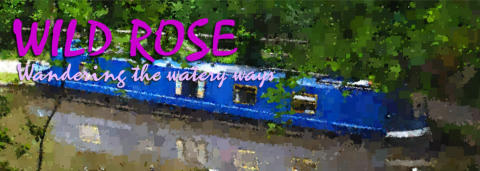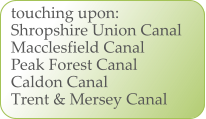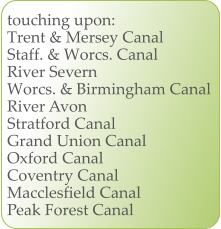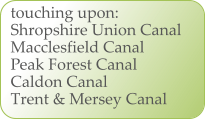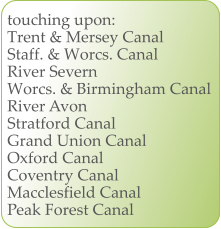

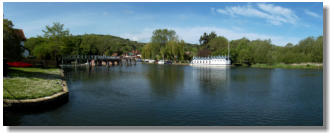
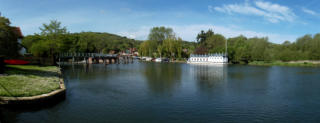

Blog history
Blog
Saturday 21st April - Trent & Mersey Canal
We have arrived in Rugby having taken time off the boat to visit Shrewsbury and Coventry, as well as briefly diverting up the Ashby Canal to while away the time waiting for the gearbox replacement, this repair having now been completed.Thursday 12th April - Trent & Mersey Canal
A family visit to Edinburgh has refreshed us, with our Granddaughter Amelia now walking, or perhaps tottering, but progressing fast! Back on board we have arrived in Nuneaton having made an appointment for the repair of a failing gearbox.Wednesday 14th March - Macclesfield Canal
We are firmly in the winter freeze as we move slowly, when ice permits, down the Maccie. We have taken the opportunity to revisit Little Morton Hall which must rank as one of the most fascinating Tudor half framed building in the country. The plan was to move onto the Shropshire Union Canal by way of the Middlewich Link and thus continue our way south, but the banks have burst on a section of the Link and it is blocked for the foreseeable future. Things do seem to conspire to block our way what with closed lock flights, collapsing bridges and now collapsing canals. Nil desperandum, we shall continue down the Trent & Mersey, onto the Coventry and thus onto the Oxford Canal.
On…on to the Thames!
Monday 7th May - Oxford Canal
Today we take a break from our frantic schedule to visit Rousham House and Gardens which is roughly 12 miles North of Oxford . This place is the work of William Kent, an eminent English architect, landscape architect and furniture designer of the early 18th century. Kent originated the 'natural' style of gardening known as the “English landscape garden” as well as introducing the “Palladian” style of architecture into England. Apparently, though, he didn’t know much about horticulture, so nobody’s perfect. Exploring the gardens we found an extraordinary memorial to an Otter-hound named Ringwood, who judging by this was the apple of his Master’s eye.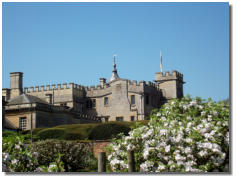
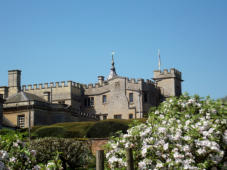
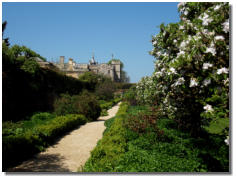
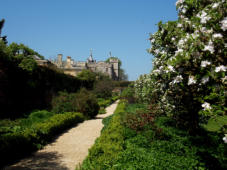
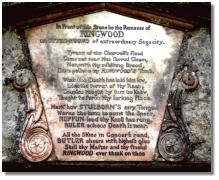
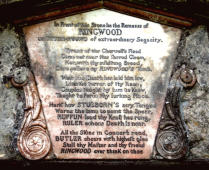
Tuesday 1st May - Oxford Canal
We have continued from Rugby down to the end of the northern Oxford Canal at Braunston Junction. For a short while the Oxford Canal and the Grand Union Canal merge into a common channel or “cut” as we boaters say. This situation continued until we reached Napton Junction where the mighty Grand Union branches off on its way North to Birmingham. We, however, stuck to the southern Oxford Canal on its pleasantly convoluted journey down to the River Thames. This Canal was created by James Brindley, the first canal engineer, who generally followed contour lines wherever he could, regardless of the additional distances this created. Presumably the contractor didn’t care, being paid be the mile! Our journey for the day finished at the picturesque village of Copredy.Friday 11th May - River Thames
We have passed down the southern Oxford, onto the Thames, and, after a rather exhausting day, onto the Kennet and Avon Canal. Mooring on this stretch of the Thames is rather problematic and so a journey from Oxford to Reading which would be comfortable in 3 days is squeezed into less than 2. Before us lie 85 widebeam locks to our mooring at the foot of Caen Hill. We had better get going.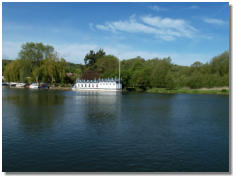
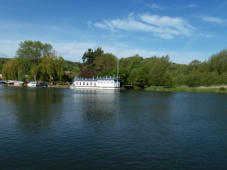
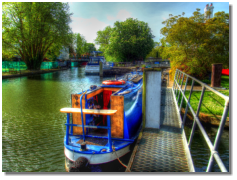
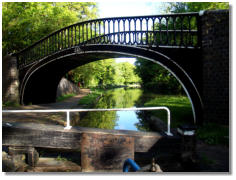
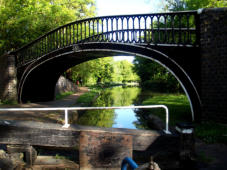
Sunday 20th May - Kennet and Avon Canal
Passing through Newbury, we move on to Kintbury where we meet a relic of days gone by - a horse drawn boat! It’s a bit like being stuck behind a tractor on a narrow road but before long the boat crew gave up or the horse refused to go any further and we passed onto a mooring just beyond the village.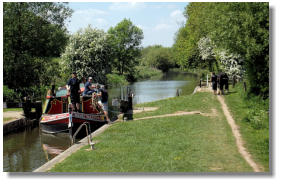
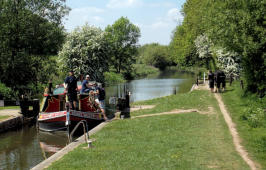
Sunday 27th May - Kennet and Avon Canal
Remember “Three men in a boat” by Jerome K. Jerome , well it’s still happening as these pictures show although a couple of lady rowers confessed to spending the nights in a Hotel. Would Jerome have approved?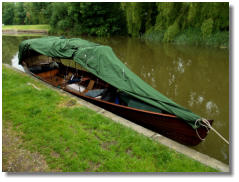
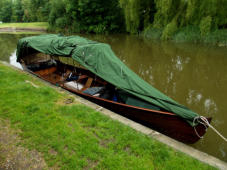
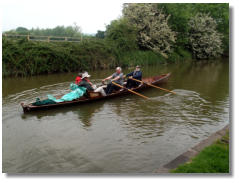
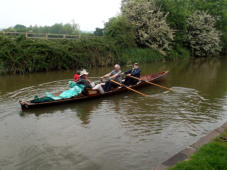
Friday 1st June - Kennet and Avon Canal
After a pleasant and relaxing cruise (the last 3 days have been lockless) we reach Devizes. Here we must “gird the loins”, for tomorrow we descend the Caen Flight of 29(!) locks. Hopefully there will be plenty of volunteers to help us or at least another boat to partner us with a large crew of energetic teenagers. Yeah...dream on.Monday 4th June - Kennet and Avon Canal
We have reached Caen Hill Marina where we will moor up for the the next 3 to 4 months and where this chronicle will pause while we deal with some non boating business of our own. Back later so watch this space. Incidentally there were volunteers but no teenagers.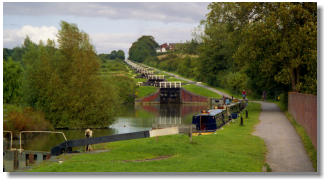
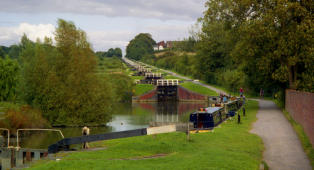
Winter Cruising 2018/19
Having returned to Wild Rose from our summer sojourn in Bournemouth we are glad to be afloat again and look forward to the winter season bumbling up and down the cut. Our route is somewhat restricted as winter maintenance has closed the Caen Flight and Bridge 199 in Bath. This gives us a cruising range between, of approximately 17 miles which doesn’t sound like much but which contains some delightful cruising and some delightful places. From Devizes to Bath passing Bradford on Avon, Trowbridge and Bathampton. This is a distinct improvement on last year where we spent most of February trapped between two bridges about one mile apart ! We now have plenty of time to enjoy this part of the Kennet and Avon Canal and, indeed, to reflect upon it’s character and history. The K&A is made up of two lengths of navigable river joined up by a canal. The rivers are the Avon from Bristol to Bath, and the Kennet from Newbury to Reading on the Thames. The two river stretches were made navigable in the early 18th century, and the 57-mile canal section was constructed between 1794 and 1810. Now the idea of an east to west waterway across southern England, effectively a watery transport link between London and Bristol was first mooted in Elizabethan times, for the tributaries of the Avon and Thames are only three miles apart at their closest point. This would avoid the hazardous sea route through the English Channel and the predation from time to time of French warships not to mention good old-fashioned pirates. Further attempts after the Civil War floundered on the rocks of vested interests worried about cheaper water transport reducing the value of fees on turnpike roads and cheaper goods from Wales flooding local markets. As with most canals the commercial value of the K&A declined with the advent and development of the railways, specifically the Great Western Railway. After the 2nd World War the canal became derelict. It is interesting to reflect how often we cruise serenely past the forlorn buttresses of a dismantled railway bridge marking a closed line...who has the last laugh? A feature of the K&A often commented, are the number of wartime pillboxes scattered along the route. The canal was designated “Stop Line Blue” to defend against German invasion as part of a vast system of defensive structures intended to frustrate the movement of armour in South-east England. In effect the K&A became an anti-tank ditch. Pill boxes were built at strategic points and anti tank obstacles are commonly found at bridges, the famous “Dragon’s Teeth”. Of course the materials for these structures were mainly carried on canal boats. The post war dereliction was not allowed to continue and in the second half of the 20th Century the K&A was brought back to life mainly by volunteers. The task was immense but in 1990 the entire 87 miles and 105 locks were fully reopened to navigation. There is no denying that parts of the canal are “difficult” being river courses and not easy for mooring. All the boats carry gang planks so “mind that gap”. But the scenery can be magical and particularly at the moment, the views over the Avon valley in the Autumn.Wednesday 5th December 2018
This is the 5th Birthday of our Granddaughters Jorja and Erin. We hope you are having a great day girls and that sometime we shall see you again. All our love from your maternal Grandparents, Uncle Stuart, Aunt Virginia, Cousin Amelia and the rest of the family.

Blog history
Blog
Wednesday 14th March - Macclesfield
Canal
We are firmly in the winter freeze as we move slowly, when ice permits, down the Maccie. We have taken the opportunity to revisit Little Morton Hall which must rank as one of the most fascinating Tudor half framed building in the country. The plan was to move onto the Shropshire Union Canal by way of the Middlewich Link and thus continue our way south, but the banks have burst on a section of the Link and it is blocked for the foreseeable future. Things do seem to conspire to block our way what with closed lock flights, collapsing bridges and now collapsing canals. Nil desperandum, we shall continue down the Trent & Mersey, onto the Coventry and thus onto the Oxford Canal.Thursday 12th April - Trent &
Mersey Canal
A family visit to Edinburgh has refreshed us, with our Granddaughter Amelia now walking, or perhaps tottering, but progressing fast! Back on board we have arrived in Nuneaton having made an appointment for the repair of a failing gearbox.Saturday 21st April - Trent & Mersey
Canal
We have arrived in Rugby having taken time off the boat to visit Shrewsbury and Coventry, as well as briefly diverting up the Ashby Canal to while away the time waiting for the gearbox replacement, this repair having now been completed.Tuesday 1st May - Oxford Canal
We have continued from Rugby down to the end of the northern Oxford Canal at Braunston Junction. For a short while the Oxford Canal and the Grand Union Canal merge into a common channel or “cut” as we boaters say. This situation continued until we reached Napton Junction where the mighty Grand Union branches off on its way North to Birmingham. We, however, stuck to the southern Oxford Canal on its pleasantly convoluted journey down to the River Thames. This Canal was created by James Brindley, the first canal engineer, who generally followed contour lines wherever he could, regardless of the additional distances this created. Presumably the contractor didn’t care, being paid be the mile! Our journey for the day finished at the picturesque village of Copredy.Monday 7th May - Oxford Canal
Today we take a break from our frantic schedule to visit Rousham House and Gardens which is roughly 12 miles North of Oxford . This place is the work of William Kent, an eminent English architect, landscape architect and furniture designer of the early 18th century. Kent originated the 'natural' style of gardening known as the “English landscape garden” as well as introducing the “Palladian” style of architecture into England. Apparently, though, he didn’t know much about horticulture, so nobody’s perfect. Exploring the gardens we found an extraordinary memorial to an Otter-hound named Ringwood, who judging by this was the apple of his Master’s eye.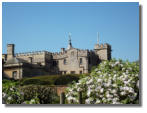
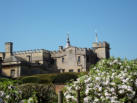
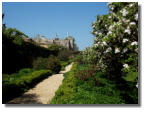
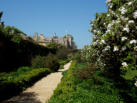
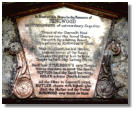
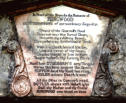
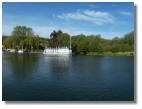

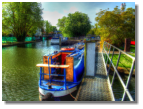
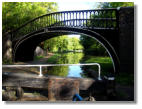

Friday 11th May - River Thames
We have passed down the southern Oxford, onto the Thames, and, after a rather exhausting day, onto the Kennet and Avon Canal. Mooring on this stretch of the Thames is rather problematic and so a journey from Oxford to Reading which would be comfortable in 3 days is squeezed into less than 2. Before us lie 85 widebeam locks to our mooring at the foot of Caen Hill. We had better get going.Sunday 20th May - Kennet and Avon
Canal
Passing through Newbury, we move on to Kintbury where we meet a relic of days gone by - a horse drawn boat! It’s a bit like being stuck behind a tractor on a narrow road but before long the boat crew gave up or the horse refused to go any further and we passed onto a mooring just beyond the village.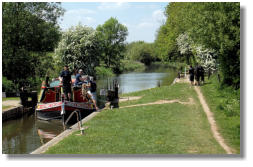
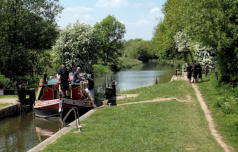
Sunday 27th May - Kennet and Avon
Canal
Remember “Three men in a boat” by Jerome K. Jerome , well it’s still happening as these pictures show although a couple of lady rowers confessed to spending the nights in a Hotel. Would Jerome have approved?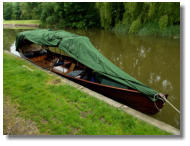
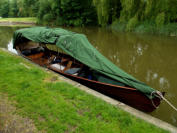
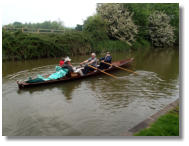
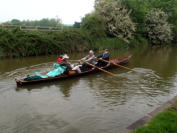
Friday 1st June - Kennet and Avon
Canal
After a pleasant and relaxing cruise (the last 3 days have been lockless) we reach Devizes. Here we must “gird the loins”, for tomorrow we descend the Caen Flight of 29(!) locks. Hopefully there will be plenty of volunteers to help us or at least another boat to partner us with a large crew of energetic teenagers. Yeah...dream on.Monday 4th June - Kennet and Avon
Canal
We have reached Caen Hill Marina where we will moor up for the the next 3 to 4 months and where this chronicle will pause while we deal with some non boating business of our own. Back later so watch this space. Incidentally there were volunteers but no teenagers.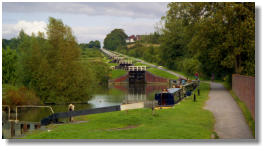
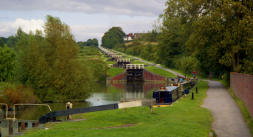
Winter Cruising 2018/19
Having returned to Wild Rose from our summer sojourn in Bournemouth we are glad to be afloat again and look forward to the winter season bumbling up and down the cut. Our route is somewhat restricted as winter maintenance has closed the Caen Flight and Bridge 199 in Bath. This gives us a cruising range between, of approximately 17 miles which doesn’t sound like much but which contains some delightful cruising and some delightful places. From Devizes to Bath passing Bradford on Avon, Trowbridge and Bathampton. This is a distinct improvement on last year where we spent most of February trapped between two bridges about one mile apart ! We now have plenty of time to enjoy this part of the Kennet and Avon Canal and, indeed, to reflect upon it’s character and history. The K&A is made up of two lengths of navigable river joined up by a canal. The rivers are the Avon from Bristol to Bath, and the Kennet from Newbury to Reading on the Thames. The two river stretches were made navigable in the early 18th century, and the 57-mile canal section was constructed between 1794 and 1810. Now the idea of an east to west waterway across southern England, effectively a watery transport link between London and Bristol was first mooted in Elizabethan times, for the tributaries of the Avon and Thames are only three miles apart at their closest point. This would avoid the hazardous sea route through the English Channel and the predation from time to time of French warships not to mention good old-fashioned pirates. Further attempts after the Civil War floundered on the rocks of vested interests worried about cheaper water transport reducing the value of fees on turnpike roads and cheaper goods from Wales flooding local markets. As with most canals the commercial value of the K&A declined with the advent and development of the railways, specifically the Great Western Railway. After the 2nd World War the canal became derelict. It is interesting to reflect how often we cruise serenely past the forlorn buttresses of a dismantled railway bridge marking a closed line...who has the last laugh? A feature of the K&A often commented, are the number of wartime pillboxes scattered along the route. The canal was designated “Stop Line Blue” to defend against German invasion as part of a vast system of defensive structures intended to frustrate the movement of armour in South-east England. In effect the K&A became an anti-tank ditch. Pill boxes were built at strategic points and anti tank obstacles are commonly found at bridges, the famous “Dragon’s Teeth”. Of course the materials for these structures were mainly carried on canal boats. The post war dereliction was not allowed to continue and in the second half of the 20th Century the K&A was brought back to life mainly by volunteers. The task was immense but in 1990 the entire 87 miles and 105 locks were fully reopened to navigation. There is no denying that parts of the canal are “difficult” being river courses and not easy for mooring. All the boats carry gang planks so “mind that gap”. But the scenery can be magical and particularly at the moment, the views over the Avon valley in the Autumn.